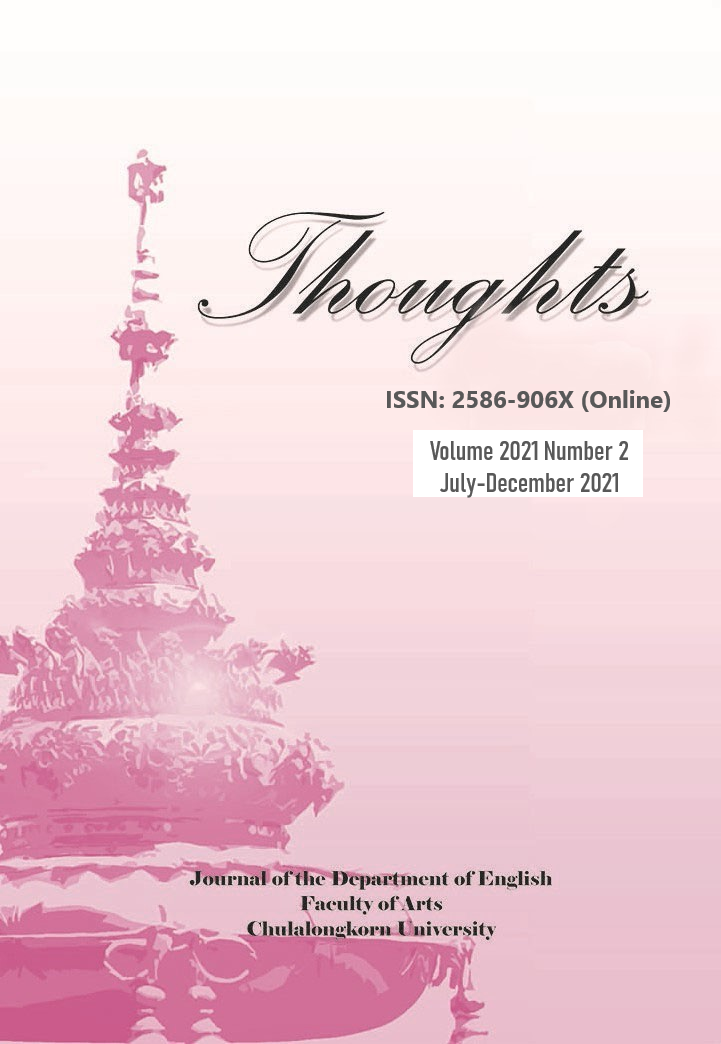Refashioning the Domestic Novel: Literary Form and Fanny Fern’s Biopolitical Imagination in Ruth Hall
DOI:
https://doi.org/10.58837/CHULA.THTS.2021.2.3Keywords:
women’s writing, American literature, domestic novel, popular fiction, the nineteenth centuryAbstract
Drawing upon the Nancy Armstrong and Leonard Tennenhouse (2008, 2018) explanation of the form of early American novels, Emily Steinlight’s (2018) concept of “demographic surplus” and Michel Foucault’s (1978/2007) concept of “population” and “mechanisms of security,” this paper seeks to extend the discussion of the importance of the presence of the population in Ruth Hall and Fanny Fern’s (1855/1997) imagination of a form of government suitable for mid-nineteenth century America. By doing so, I suggest that Ruth Hall can be considered a novel that shares the legacy of the literary tradition that was once believed to be exclusive to male writers.
References
Agamben, G. (1998). Homo sacer: Sovereign power and bare life (D. Heller-Roazen, Trans.). Stanford University Press. (Original work published 1995)
Anbinder, T. (2016). City of dreams: The 400-year epic history of immigrant New York. Houghton Mifflin Harcourt.
Armstrong, N. (2006). What feminism did to novel studies. In E. Rooney (Ed.), The Cambridge companion to feminist literary theory (pp. 99–118). Cambridge University Press.
Armstrong, N., & Tennenhouse, L. (2008). The problem of population and the form of the American novel. American Literary History, 20(4), 667–685.
Armstrong, N., & Tennenhouse, L. (2018). Novels in the time of democratic writing: The American example. University of Pennsylvania Press.
Baym, N. (1978). Woman’s fiction: A guide to novels by and about women in America, 1820-1870. Cornell University Press.
Baym, N. (1981). Melodramas of beset manhood: How theories of American fiction exclude women authors. American Quarterly, 33(2), 123-139.
Cutter, M. J. (1999). Unruly Tongue: Identity and voice in American women’s writing, 1850-1930. University Press of Mississippi.
Deleuze, G., & Guattari, F. (2005). A thousand plateaus: Capitalism and schizophrenia (B. Massumi, Trans.). University of Minnesota Press. (Original work published 1980)
Douglas, M. (2001). Purity and danger: An analysis of the concepts of pollution and taboo. Taylor & Francis e-Library. https://monoskop.org/images/7/7d/Douglas_Mary_Purity_and_Danger_An_Analysis_of_Concepts_of_Pollution_and_Taboo_2001.pdf (Original work published 1966)
Fern, F. (1997). Ruth Hall: A domestic tale of the present time. (S. Belasco, Ed). Penguin Classics. (Original work published 1855)
Foucault, M. (2003). “Society must Be defended”: Lecture at the Collège De France 1975-1976 (M. Bertani & A. Fontana, Eds.; D. Macey, Trans.). Picador. (Original work published 1976)
Foucault, M. (2007). Security, Territory, Population: Lectures at the Collège De France 1977-1978 (M. Senellart, Ed.; G. Burchell, Trans.). Picador/Palgrave Macmillan. (Original work published 1978)
Harris, J. (2006). Marketplace transactions and sentimental currencies in Fanny Fern’s Ruth Hall. American Transcendental Quarterly, 20(1), 343–359.
Harris, S. K. (1992). Nineteenth-century American women’s novels: Interpretative strategies. Cambridge University Press.
Homestead, M. J. (2001). “Everybody sees the theft”: Fanny Fern and literary proprietorship in Antebellum America. The New England Quarterly, 74(2), 210–237.
Kreilkamp, I. (2018). Minor creatures: Persons, animals, and the Victorian novel. University of Chicago Press.
Matthiessen, F. O. (1968). American renaissance: Art and expression in the age of Emerson and Whitman. Oxford University Press. (Original work published 1941)
Pfister, J. (1991). The production of personal life: Class, gender, and the psychological in Hawthorne’s fiction. Stanford University Press.
Roberts, S. S. (2014). Gothic subjects: The transformation of individualism in American fiction, 1790-1861. University of Pennsylvania Press.
Sánchez, M. C. (2000). Re-possessing individualism in Fanny Fern’s Ruth Hall. Arizona Quarterly: A Journal of American Literature, Culture, and Theory, 56(4), 25–56.
Steinlight, E. (2018). Populating the novel: Literary form and the politics of surplus life. Cornell University Press.
Temple, G. (2003). A purchase on goodness: Fanny Fern, Ruth Hall, and fraught individualism. Studies in American Fiction, 31(2), 131–163.
Tompkins, J. (1985). Sensational designs: The cultural work of American fiction 1790-1860. Oxford University Press.
Warren, J. W. (1993a). Introduction: Canons and canon fodder. In J. W. Warren (Ed.), The (other) American traditions: Nineteenth-century women writers (pp. 1–25). Rutgers University Press.
Warren, J. W. (1993b). Domesticity and the economics of independence: Resistance and revolution in the work of Fanny Fern. In J. W. Warren (Ed.), The (other) American traditions: Nineteenth-century women writers (pp. 73–91). Rutgers University Press.
Warren, J. W. (1993c). Preface. In J. W. Warren (Ed.), The (other) American traditions: Nineteenth-century women writers (pp. vii–ix). Rutgers University Press.
Warren, J. W. (2005). Introduction. In J. W. Warren (Ed.), Ruth Hall and other writings (pp. ix–xxxix). Rutgers University Press. (Original work published 1986)
Weyler, K. A. (2005). Literary labors and intellectual prostitution: Fanny Fern’s defense of working women. South Atlantic Modern Language Association, 70(2), 96–131.
Woloch, A. (2003). The one vs the many: Minor characters and the space of the protagonist in the novel. Princeton University Press.
Wood, A. D. (1971). The “scribbling women” and Fanny Fern: Why women wrote. American Quarterly, 23(1), 3–24.
Downloads
Published
Issue
Section
License
Copyright (c) 2021 Thoughts

This work is licensed under a Creative Commons Attribution-NonCommercial-NoDerivatives 4.0 International License.
Copyright by the Faculty of Arts, Chulalongkorn University.
Photocopying is allowed for internal, non-commercial use only. Photocopying for other uses or for purposes other than indicated must be permitted in writing from the Faculty of Arts, Chulalongkorn University.
All views or conclusion are those of the authors of the articles and not necessarily those of the publisher or the editorial staff.


